California
 Earthquakes can happen anywhere, but there are areas that are more prone to earthquakes than other areas. When we think about that, we think of Alaska, California, or Japan, all of which experience daily earthquakes. Of course, there are many other places that get a lot of earthquakes. One such place is in Italy. The area around Sicily and Calabria are known as la terra ballerina, “the dancing land,” for the periodic seismic activity that strikes the region. I would have thought that with 12,000 earthquakes a year in Alaska, or 10,000 earthquakes a year in California, or 1,500 earthquakes in Japan, that any of these places would be called “the dancing land” before the area of Sicily and Calabria, which doesn’t have nearly as many.
Earthquakes can happen anywhere, but there are areas that are more prone to earthquakes than other areas. When we think about that, we think of Alaska, California, or Japan, all of which experience daily earthquakes. Of course, there are many other places that get a lot of earthquakes. One such place is in Italy. The area around Sicily and Calabria are known as la terra ballerina, “the dancing land,” for the periodic seismic activity that strikes the region. I would have thought that with 12,000 earthquakes a year in Alaska, or 10,000 earthquakes a year in California, or 1,500 earthquakes in Japan, that any of these places would be called “the dancing land” before the area of Sicily and Calabria, which doesn’t have nearly as many.
Nevertheless, the name was given and it stuck. While it may not have as many, the ones that hit there seem to be especially devastating. In 1693, 60,000 people were killed in southern Sicily by an earthquake, and in 1783 most of the Tyrrenian coast of Calabria was leveled by a massive earthquake that 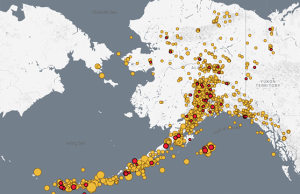 killed 50,000. The quake of 1908 was particularly costly in terms of human life because it struck at at dawn, catching most people at home in bed rather than in the relative safety of the streets or fields. The December 28, 1908 earthquake which struck at 5:20am was the most destructive earthquake in recorded European history strikes the Straits of Messina in southern Italy. The cities of Messina in Sicily and Reggio di Calabria on the Italian mainland were leveled by the devastating quake. The earthquake and tsunami it caused killed an estimated 100,000 people. The main shock registered an estimated 7.5 magnitude on the Richter scale. It caused a devastating tsunami with 40-foot waves that washed over coastal towns and cities. The two major cities on either side of the Messina Straits–Messina and Reggio di Calabria, had about 90 percent of their buildings destroyed. The quake cut telegraph lines and damaged railway lines, seriously slowing down the relief efforts. To make matters worse, many of the remaining buildings were destroyed by hundreds of smaller
killed 50,000. The quake of 1908 was particularly costly in terms of human life because it struck at at dawn, catching most people at home in bed rather than in the relative safety of the streets or fields. The December 28, 1908 earthquake which struck at 5:20am was the most destructive earthquake in recorded European history strikes the Straits of Messina in southern Italy. The cities of Messina in Sicily and Reggio di Calabria on the Italian mainland were leveled by the devastating quake. The earthquake and tsunami it caused killed an estimated 100,000 people. The main shock registered an estimated 7.5 magnitude on the Richter scale. It caused a devastating tsunami with 40-foot waves that washed over coastal towns and cities. The two major cities on either side of the Messina Straits–Messina and Reggio di Calabria, had about 90 percent of their buildings destroyed. The quake cut telegraph lines and damaged railway lines, seriously slowing down the relief efforts. To make matters worse, many of the remaining buildings were destroyed by hundreds of smaller 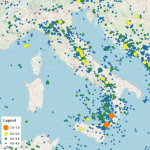 tremors over subsequent days. These tremors injured or killed rescuers. On December 30, King Victor Emmanuel III arrived aboard the battleship Napoli to inspect the devastation.
tremors over subsequent days. These tremors injured or killed rescuers. On December 30, King Victor Emmanuel III arrived aboard the battleship Napoli to inspect the devastation.
To make matters worse, a steady rain fell on the ruined cities, forcing the dazed and injured survivors, clad only in their nightclothes, to take shelter in caves, grottoes, and impromptu shacks built out of materials salvaged from the collapsed buildings. Veteran sailors could barely recognize the shoreline because long stretches of the coast had sunk several feet into the Messina Strait. The devastation was horrific. After all that, I can see why it is called la terra ballerina, “the dancing land.”
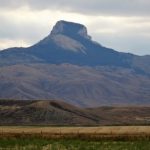
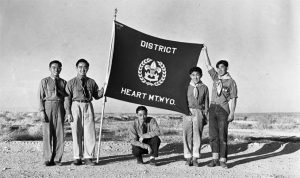 In the middle of a war, the people of a nation become concerned about anyone who might potentially be the enemy, especially if they are living inside the country’s borders. It is really a natural reaction to enemy personnel. After the Japanese attacked Pearl Harbor, the United states became quite concerned about the Japanese immigrants in our country, whether they were here legally or not. Much of the immigration to the United States from Japan began in 1884, when thousands of Japanese arrived in Hawaii to work the sugar cane fields. In the wake of the 1882 Chinese Exclusion Act, which drastically restricted Chinese immigration, Japanese people began arriving and began to prosper and started small businesses or became farmers. Most of them settled along the West Coast, meaning roughly 13,000 people of Japanese descent lived in the Intermountain West prior to World War II. The attack on Pearl Harbor, heightened the level of concern about those people.
In the middle of a war, the people of a nation become concerned about anyone who might potentially be the enemy, especially if they are living inside the country’s borders. It is really a natural reaction to enemy personnel. After the Japanese attacked Pearl Harbor, the United states became quite concerned about the Japanese immigrants in our country, whether they were here legally or not. Much of the immigration to the United States from Japan began in 1884, when thousands of Japanese arrived in Hawaii to work the sugar cane fields. In the wake of the 1882 Chinese Exclusion Act, which drastically restricted Chinese immigration, Japanese people began arriving and began to prosper and started small businesses or became farmers. Most of them settled along the West Coast, meaning roughly 13,000 people of Japanese descent lived in the Intermountain West prior to World War II. The attack on Pearl Harbor, heightened the level of concern about those people.
It was decided that, because their loyalties could not positively be confirmed, the Japanese immigrants needed to be rounded up and put in concentration camps. I suppose this might have seemed similar to what the Germans did to the Jewish people, but the Japanese people were not murdered in the camps, like the Jews were. And so it came to be that the people of Japanese descent from Oregon, Washington and California were incarcerated at the Heart Mountain Relocation Center in Park County, Wyoming, by the executive order of President Franklin Roosevelt. The prisoners were held at the camp from August 12, 1942 to November 10, 1945, which was actually two months after the end of the war with Japan. The camp was populated with 10,000 people at its largest, making it the third largest town in the state at the time.
I have tried to imagine what it must have been like for those Japanese immigrants to be held in the Heart Mountain Relocation Center for as much as 2 years and 3 months. Of course, the illegal immigrants of our time immediately came to my mind, but there is a difference between these people and the illegal immigrants of today. These people were here legally, and most of them had already become citizens. Unfortunately, that did not calm the worried minds of the rest of the people of the United States. Our nation had been attacked, and the attackers looked just like the Japanese immigrants. Precautions had to be taken. I’d like to think that if it were me, in that position, that I would understand why this was happening, but I’m not so sure I would. After all, these people were not criminals. They were hard working Americans, and yet they were for a time…the enemy, or possibly the enemy.
Unfortunately, like many prior immigrant groups, the Japanese faced discrimination. Things aren’t always fair, and people aren’t always treated properly. Starting in the early 20th century, Japanese immigrants, as well as Chinese immigrants, were targeted by Alien Land Laws in western states including Wyoming. These laws prevented the Asian immigrants from buying land. In 1924, the United States Congress passed the Asian Exclusion Act, which all but cut off new immigration from Asia. In response, Japanese Americans formed organizations such as the Japanese American Citizens’ League to help address their shared challenges. Despite 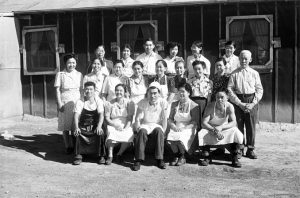 the attempts of Japanese Americans to fit in, some people expressed ongoing skepticism regarding the place of Asians in American society.
the attempts of Japanese Americans to fit in, some people expressed ongoing skepticism regarding the place of Asians in American society.
The Heart Mountain facility consisted of 450 barracks, each containing six apartments, when the first internees arrived on August 12, 1942. The largest apartments were simply single rooms measuring 24 feet by 20 feet. The barracks were covered with tar paper. While each unit was eventually outfitted with a potbellied stove, none had bathrooms. The people all used shared latrines. None of the apartments had kitchens. The residents ate their meals in mess halls. When the people first arrived, a barbed-wire fence to surround the camp was not yet complete. The internees protested the construction of this barrier and caused further work to be delayed. In November 1942, they submitted a petition containing 3,000 signatures to the War Relocation Authority (WRA) Director Dillon Meyer. The fence was completed by December, however, and further emphasized the sense of confinement among the internees. Shortly after the construction of the fence, 32 boys were arrested for sledding in the hills beyond the boundary. In response to the perceived overreaction on the part of the camp administration, Rikio Tomo, a Heart Mountain internee, placed an editorial in the Heart Mountain Sentinel asking for clarification about the internees’ citizenship status and constitutional freedoms. Schools were built at Heart Mountain, including a high school, to accommodate the children. These schools served students from elementary school through high school. Roughly 1500 students attended Heart Mountain High School, which included grades 8-12.
The internees provided most of the labor required to run the Heart Mountain camp, while WRA administrators oversaw its general operations. Wages ranged from $12 per month for unskilled labor to $19 per month for skilled labor, including teachers for the schools and doctors in the camp hospitals. In addition, Heart Mountain internees also worked as manual laborers on farms and ranches in Wyoming and nearby states from Nebraska to Oregon. The WRA administrators encouraged activities emphasizing American civics, such as scouting and adult English classes, as part of what they saw as an Americanization process. Committees composed initially of American-born internees provided much of the day-to-day governance of the camps. While these groups provided some measure of self-determination, they disrupted the generational hierarchy. American-born adults in their 20s and 30s were given a higher political status within the camps than their Japanese-born parents.
In 1943, General George Marshall approved the creation of the Japanese-American combat unit. As a result of the low turnout, the War Department extended the draft to the camps. It was decided that while they were not free to go where they chose, these people were needed to serve their country, so a draft was instituted. After they were drafted into the U.S. Army, soldiers from Heart Mountain occasionally returned to visit their families who were still held there. Somehow that doesn’t seem quite fair to me, and many of the prisoners agreed. They thought they should have been given their constitutional rights back before they were drafted. The organization of draft resistance distinguished Heart Mountain from the other relocation centers. The plan, which was given the endorsement of President Roosevelt, was to create an all-Japanese regiment, consisting of soldiers from a previously existing Hawaiian unit and volunteers from the camps. The response from within the camps fell far short of expectations, partly because of a loyalty questionnaire distributed by the WRA. The WRA form was used to determine eligibility for military service and permanent leave. Many of the questions were considered intrusive by prisoners. Others were not as straightforward as the WRA probably intended. Instead of serving as a neutral tool to determine someone’s suitability for service, the questionnaire further alienated many the men. To me it seems that the WRA was somehow not aware of how racist the entire situation really was. For example, question 27 asked about a person’s willingness to serve in the military. For 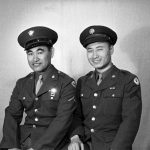
 prisoners who felt service should be contingent upon the restoration of constitutional rights to all Japanese Americans, a simple yes or no answer was insufficient. In each of the camps, the draft became a divisive issue. While some prisoners felt military service was an opportunity to exemplify patriotism, others felt that constitutional rights should be restored before agreeing to mandatory service. I doubt if the situation would have ever really been resolved, except that the war ended.
prisoners who felt service should be contingent upon the restoration of constitutional rights to all Japanese Americans, a simple yes or no answer was insufficient. In each of the camps, the draft became a divisive issue. While some prisoners felt military service was an opportunity to exemplify patriotism, others felt that constitutional rights should be restored before agreeing to mandatory service. I doubt if the situation would have ever really been resolved, except that the war ended.

 About 47 years ago, while on a family vacation to California, my brother-in-law, Ron Schulenberg decided that he wanted to stay in California, and when asked what they should do about his older brother, Bob, Ron said,”just send for him in the mail.” Unfortunately, Ron was a little late in history for his cool little idea. You see, while the mailing of children was a practice between 1913 and 1920, Ron was living in the year 1971. Nevertheless, while Ron’s idea was workable, he cannot be credited with the original idea.
About 47 years ago, while on a family vacation to California, my brother-in-law, Ron Schulenberg decided that he wanted to stay in California, and when asked what they should do about his older brother, Bob, Ron said,”just send for him in the mail.” Unfortunately, Ron was a little late in history for his cool little idea. You see, while the mailing of children was a practice between 1913 and 1920, Ron was living in the year 1971. Nevertheless, while Ron’s idea was workable, he cannot be credited with the original idea.
When the Post Office’s Parcel Post service officially began on January 1, 1913, the new service suddenly allowed millions of Americans access to all kinds of goods and services. That was a great thing, but as is often the case, it almost immediately had some unintended consequences. Believe it or not, some parents decided to send their children through the mail. Just a few weeks after Parcel Post began, an Ohio couple named Jesse and Mathilda Beagle “mailed” their 8-month-old son James to his grandmother, who lived just a few miles away in Batavia. It seems that Baby James was just under the 11-pound weight limit for packages sent via Parcel Post, and his “delivery” cost his parents only 15 cents in postage. Of course, being the “responsible parents” they were, they did insure him for $50. As you can imagine, this “delivery” made the newspapers very quickly. While you might have thought about the outrage that would have come from such an action these days, it did not. In fact, for the next several years, similar stories would occasionally surface as other parents followed suit. One famous case, on February 19, 1914, was that of a four year old girl named Charlotte May Pierstorff was “mailed” via train from her home in Grangeville, Idaho to her grandparents’ house about 73 miles away. Nancy Pope, who wrote for the National Postal Museum wrote the story, which became so legendary, that it was even made into a children’s book, Mailing May. Luckily, little May wasn’t unceremoniously shoved into a canvas sack along with the other packages. As it turns out, she was accompanied on her trip by her mother’s cousin, who worked as a clerk for the railway mail service, according to United States Postal Service historian Jenny Lynch. It’s likely that his influence (and his willingness to chaperone his young cousin) is what convinced local officials to send the little girl along with the mail.
In the next few years, stories about children being mailed through rural routes would crop up from time to time as people pushed the limits of what could be sent through Parcel Post. The reason being that postage was cheaper than a train ticket. One of the most overlooked, yet most significant innovations of the early 20th century might be the Post Office’s decision to start shipping large parcels and packages through the mail. While private delivery companies flourished during the 19th century, the Parcel Post dramatically expanded the reach of mail-order companies to America’s many rural communities, as well as the demand for their products. Over the years, these stories continued to surface from time to time as parents occasionally managed to slip their children through the mail thanks to rural workers willing to let it slide. Finally, on June 14, 1913, several newspapers including the Washington Post, the New York Times, and the Los Angeles Times all ran stories stating the the postmaster had officially decreed that children could no longer be sent through the mail. But while this announcement seems to have stemmed the trickle of tots traveling via post, Lynch says the story wasn’t entirely accurate. Soon, it became obvious that this bizarre practice had to be stopped, and on June 13, 1920, notice was given that the Post Office would no longer let children be sent through the mail. While child 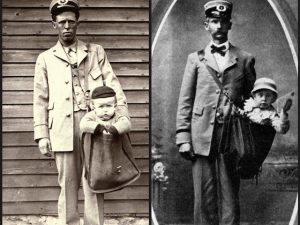
 mailing stopped, there was a time when “Mail carriers were trusted servants, and that goes to prove it. There are stories of rural carriers delivering babies and taking care of the sick. Even now, they’ll save lives because they’re sometimes the only persons that visit a remote household every day.” Still, I don’t think I would mail my child somewhere. Thankfully, there are more travel options for children these days than pinning some postage to their shirts and sending them off with the mailman.
mailing stopped, there was a time when “Mail carriers were trusted servants, and that goes to prove it. There are stories of rural carriers delivering babies and taking care of the sick. Even now, they’ll save lives because they’re sometimes the only persons that visit a remote household every day.” Still, I don’t think I would mail my child somewhere. Thankfully, there are more travel options for children these days than pinning some postage to their shirts and sending them off with the mailman.
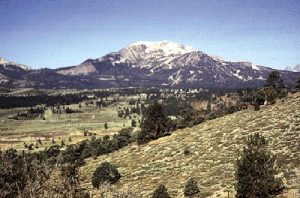 During the gold rush years, in 1857, to be exact, two German men who had been traveling with a wagon train headed to California, decided to leave the rest of the group and headed out on their own. They wound up in the Mono Lake region of northern California. One of the men would later describe the area as “the burnt country.” While crossing the Sierra Nevada near the headwaters of the Owens River, they sat down to rest near a stream. Looking around, they noticed a curious looking rock ledge of red lava filled with what appeared to be pure lumps of gold “cemented” together. That was how their “mine” got its name.
During the gold rush years, in 1857, to be exact, two German men who had been traveling with a wagon train headed to California, decided to leave the rest of the group and headed out on their own. They wound up in the Mono Lake region of northern California. One of the men would later describe the area as “the burnt country.” While crossing the Sierra Nevada near the headwaters of the Owens River, they sat down to rest near a stream. Looking around, they noticed a curious looking rock ledge of red lava filled with what appeared to be pure lumps of gold “cemented” together. That was how their “mine” got its name.
The ledge of that hillside was literally loaded with the ore. The excited men couldn’t believe their eyes. One of the men was laughing at the other as he pounded away about ten pounds of the ore to take with him…because he did not believe it was really gold. The man who believe that it was gold drew a map to the location and the two men continued their journey. Along the way, the disbeliever died and since he was laden with so much ore, the believer tossed the majority of the samples. Then, after crossing the mountains, he followed the San Joaquin River to the mining camp of Millerton, California. After a long, weary journey, the German had become ill and soon went to San Francisco for treatment. He was diagnosed and cared for by a Doctor Randall who told the man he was terminally ill with consumption (tuberculosis). With no money to pay the doctor and too ill to return to the treasure, he paid his caretaker with the ore, the map he had drawn, and provided him with a detailed description.
Doctor Randall shared this knowledge with a few of his friends and together they decided to go for the gold. They arrived at old Monoville in the spring of 1861. After enlisting additional men to help, Randall’s group began to prospect on a quarter-section of land called Pumice Flat. Their claim is thought to have been some eight miles north of Mammoth Canyon…the 120 acres were near what became known as Whiteman’s Camp. Word of possibly a huge cache of gold spread quickly and before long miners flooded the area hunting for the gold laden red “cement.” One story tells that two of Doctor Randall’s party had in fact found the “Cement Mine,” taking several thousand dollars from the ledge. Unfortunately, for those two men, the area was filled with the Owens Valley Indian War which began in 1861. The Paiute Indians, who had heretofore been generally peaceful, were angered at the large numbers of prospectors who had invaded their lands. The two miners who 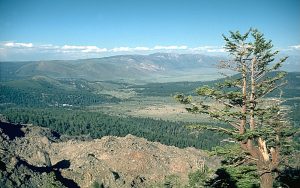 had allegedly found the lost ledge were killed by the Indians before they were able to tell of its location.
had allegedly found the lost ledge were killed by the Indians before they were able to tell of its location.
Though the “cement” outcropping was never found again, the many prospectors who flooded the eastern Sierra region did find gold. Apparently there was a huge cache there after all. This resulted in the mining camps of Dogtown, Mammoth City, Lundy Canyon, Bodie, and many others. The lost lode is said to lie somewhere in the dense woods near the Sierra Mountain headwaters of the San Joaquin River’s middle fork. If it really exists, it must be very well hidden.
 Stagecoach drivers like Charley Parkhurst were tough as nails. Not everyone could handle a stagecoach. The stagecoach driver was respected…sometimes even more than was the millionaire statesman who might be riding beside him, or anyone else who had been given that honor. Parkhurst had been through the good times and bad times of driving stagecoach. Twice, Charley was held up. The first time, he was forced to throw down his strongbox because he was unarmed. The second time, he was prepared. When a road agent ordered the stage to stop and commanded Charley to throw down its strongbox, Parkhurst leveled a shotgun blast into the chest of the outlaw, whipped his horses into a full gallop, and left the bandit in the road.
Stagecoach drivers like Charley Parkhurst were tough as nails. Not everyone could handle a stagecoach. The stagecoach driver was respected…sometimes even more than was the millionaire statesman who might be riding beside him, or anyone else who had been given that honor. Parkhurst had been through the good times and bad times of driving stagecoach. Twice, Charley was held up. The first time, he was forced to throw down his strongbox because he was unarmed. The second time, he was prepared. When a road agent ordered the stage to stop and commanded Charley to throw down its strongbox, Parkhurst leveled a shotgun blast into the chest of the outlaw, whipped his horses into a full gallop, and left the bandit in the road.
Charley Parkhurst was one of the more skillful stagecoach drivers, not only in  California, but throughout the west. He was often called “One-eyed” or “Cockeyed” Charley, because he had lost an eye when kicked by a horse. He drove a stagecoach in California for 20 years. One-eyed Charley was known as one of the toughest, roughest, and the most daring of all stagecoach drivers. Like most drivers, he was proud of his skill in the extremely difficult job as “whip.” A “whip” is what stagecoach drivers were often called. Proper handling of the horses and the great coaches was an art that required much practice, experience, and not the least, courage. Whips received high salaries for the times, sometimes as much as $125 a month, plus room and board. While most stage drivers were sober, at least while on duty, nearly all were fond of an occasional “eye opener.” A good driver was the captain of his craft. His timid passengers feared him. He was
California, but throughout the west. He was often called “One-eyed” or “Cockeyed” Charley, because he had lost an eye when kicked by a horse. He drove a stagecoach in California for 20 years. One-eyed Charley was known as one of the toughest, roughest, and the most daring of all stagecoach drivers. Like most drivers, he was proud of his skill in the extremely difficult job as “whip.” A “whip” is what stagecoach drivers were often called. Proper handling of the horses and the great coaches was an art that required much practice, experience, and not the least, courage. Whips received high salaries for the times, sometimes as much as $125 a month, plus room and board. While most stage drivers were sober, at least while on duty, nearly all were fond of an occasional “eye opener.” A good driver was the captain of his craft. His timid passengers feared him. He was  held in awe by stable boys, and was the trusty agent of his employer…and Charley was the best.
held in awe by stable boys, and was the trusty agent of his employer…and Charley was the best.
Nevertheless, little was really known about Charley Parkhurst before or after he came to California. It wasn’t until his body was prepared for burial that his true secret was discovered. Charlotte “Charley” Parkhurst was a woman. One doctor claimed that at some point in her life, she had been a mother. Unknowingly, Parkhurst could claim a national first. After voting on Election Day, November 3, 1868, Charley was probably the first woman to cast a ballot in any election. It wasn’t until 52 years later that the right to vote was guaranteed to women by the nineteenth amendment.
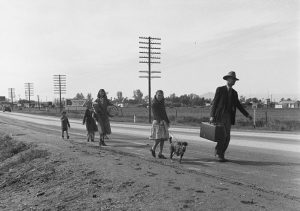
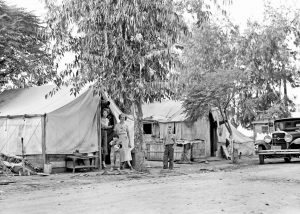 The “Dust Bowl” was an environmental disaster that hit the Midwest in the 1930s. A combination of a severe water shortage and harsh farming techniques caused the disaster. Some scientists believe it was the worst drought in North America in 300 years. The lack of rain killed the crops that kept the soil in place. When winds blew, they raised enormous clouds of dust. It deposited mounds of dirt on everything, even covering houses. With the Dust Bow came the failure of many farms in the Midwest, and the people had no choice but to move, in order to find a way to make a living.
The “Dust Bowl” was an environmental disaster that hit the Midwest in the 1930s. A combination of a severe water shortage and harsh farming techniques caused the disaster. Some scientists believe it was the worst drought in North America in 300 years. The lack of rain killed the crops that kept the soil in place. When winds blew, they raised enormous clouds of dust. It deposited mounds of dirt on everything, even covering houses. With the Dust Bow came the failure of many farms in the Midwest, and the people had no choice but to move, in order to find a way to make a living.
I suppose that the invasion that followed might have been similar to the current refugees. It wasn’t just one family that moved, but hundreds of families. Los Angeles Police Chief James E. Davis, seeking to halt the “invasion” of dust-bowl Depression refugees in February, 1936, declared a “Bum Blockade” to stop the mass emigration of poverty stricken families fleeing from the dust-torn states of the Midwest. These days, he would have met with severe criticism, not so much for the blockade, as for the name of the blockade.
By 1934, 75% of the United States was severely affected by this terrible drought. The region most affected was the Great Plains, and included more than 100 million acres, centered in Oklahoma, the Texas Panhandle, Kansas, and parts of Colorado and New Mexico. These millions of acres of farmland became useless and soon, hundreds of thousands of people were forced to leave their homes. Many of these destitute families packed up their belongings and migrated west, hoping to find work and a better life, about 200,000 of which were California bound. Instead of finding the promised land of their dreams, however, they found that the available labor pool was vastly disproportionate to the number of job openings that could be filled. Migrants who found employment soon learned that this surplus of workers caused a significant reduction in the going wage rate, and even when the entire family worked, they were unable to support themselves.
Many set up “ditchbank” camps along irrigation canals in the farmers’ fields, which brought with them poor sanitary conditions and created a public health problem. And, of those who could find work in agriculture, it did not put an end to their travels. Instead, their lives were characterized by transience, if they wanted to maintain a steady income, which required them to follow the various harvests around the state. In the meantime, California was overwhelmed, trying to figure out how to absorb as many as 6,000 migrants crossing its borders daily. Also feeling the effects of the Depression, California infrastructures were already overburdened, and the steady stream of newly arriving migrants was more than the system could bear. Though these refugees came from a number of states, Californians often lumped them together as “Okies” or “Arkies,” who became the butt of derogatory jokes and the focus of political campaigns in which candidates made them the scapegoat for a shattered economy. They were accused of many crimes, as well as shiftlessness, lack of ambition, school overcrowding and stealing jobs from native Californians.
California’s Indigent Act was passed in 1933, which made it a crime to bring indigent persons into the state, Davis contended that his men needed no special approval because “any officer has the authority to enforce the state law.” Asking border-county sheriffs to deputize his officers, most complied. However, some refused, including Modoc County, who forced 14 LAPD officers to leave after they turned away local residents trying to 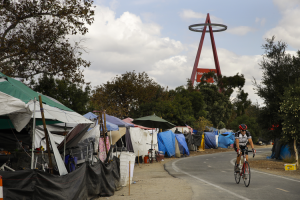
 return home. On August 24, 1935, the Los Angeles Herald-Express ran an article warning emigrants to stay away from California. It read: Stay Away From California: Warning To Transient Hordes. Those days were very different from the California of today, and not in a good way. I don’t agree with derogatory name calling, but common sense tells us that sometimes you have to try to stop a flood, even if it’s a flood of people.
return home. On August 24, 1935, the Los Angeles Herald-Express ran an article warning emigrants to stay away from California. It read: Stay Away From California: Warning To Transient Hordes. Those days were very different from the California of today, and not in a good way. I don’t agree with derogatory name calling, but common sense tells us that sometimes you have to try to stop a flood, even if it’s a flood of people.
 Unfortunately, these days, school shootings, while shocking every time, are not totally uncommon in this country. The reasons for the shootings vary, but are often blamed on bullying, loneliness, or anger for perceived wrongs. They never solve anything, least of all for the shooter, who is usually dead, or in prison after the heinous deed is done. The rest of the world is left wondering why, and how we can fix this. Of course, there are always the anti-gun advocates who say that the only solution is to take the guns out of the hands of the citizens, but as most sensible people know, guns don’t kill people, people kill people.
Unfortunately, these days, school shootings, while shocking every time, are not totally uncommon in this country. The reasons for the shootings vary, but are often blamed on bullying, loneliness, or anger for perceived wrongs. They never solve anything, least of all for the shooter, who is usually dead, or in prison after the heinous deed is done. The rest of the world is left wondering why, and how we can fix this. Of course, there are always the anti-gun advocates who say that the only solution is to take the guns out of the hands of the citizens, but as most sensible people know, guns don’t kill people, people kill people.
In 1979, I was a busy, young mother, when the first school shooting took place. The date was January 29, 1979. The place was Grover Cleveland Elementary School in San Diego, California. The shooter was 16 year old Brenda Spencer. I have to assume that she is some relation to me, as researchers have claimed that all the Spencers in the United States are related. That thought in itself makes me sad. People have the potential to become such great things, and there are so many wonderful things that a person could be the first to accomplish. So, why on that day, did young Brenda Spencer decide to take the lives of to men and wound nine children at the school across the street from her home. Her stated reasons were several…”I like red jackets,” “It livens up the day,” “I had no reason for it, and it was just fun,” “It was like shooting ducks in a pond,” “The children looked like a herd of cows standing around,” “It was really easy pickings,” And the one that stuck with the crime forever, “I just don’t like Mondays.” There is no good reason to decide to go out and kill people, but that last one stuck in my head. She didn’t like Mondays, so she ruined her own life, killed 2 men and wounded 9 children!!
Of course, I doubt if Mondays, red jackets, boredom, or animals had anything to do with it. In my opinion, the cause is mental illness. I’m not excusing her actions, because murder is a heinous crime. Brenda did not just wake up that day and decide to shoot up the school. She was a problem child, who was widely known as a drug abuser with a violent streak, such as repeatedly shooting BBs at the windows of the school. Still, her father gave her a .22 semi-automatic rifle and ammunition as a Christmas gift at the end of 1978. I’m sure he thought that her BB shooting was a harmless prank, but with the drugs and anger simmering inside her, he was wrong. She had started telling her classmates that she was going to do something “to get on TV.”
That January morning, as the children were entering the school, Brenda Spencer blazed away with rifle shots  from her home directly across the street from the school. After 20 minutes of shooting, police surrounded Spencer’s home for six hours before she surrendered. Brenda Spencer had become the first person to commit a school shooting. Asked for some explanation for the attack, she simply said, “I just don’t like Mondays. I did this because it’s a way to cheer up the day. Nobody likes Mondays.” Spencer’s hatred for the first day of the school week was later memorialized by Bob Geldof, the leader of the rock group The Boomtown Rats, in the song, “I Don’t Like Mondays.” Spencer, who pled guilty to two counts of murder and assault with a deadly weapon, is currently serving a term of 25 years to life at the California Institution for Women in Corona, California, and she was denied parole four times, most recently in 2005.
from her home directly across the street from the school. After 20 minutes of shooting, police surrounded Spencer’s home for six hours before she surrendered. Brenda Spencer had become the first person to commit a school shooting. Asked for some explanation for the attack, she simply said, “I just don’t like Mondays. I did this because it’s a way to cheer up the day. Nobody likes Mondays.” Spencer’s hatred for the first day of the school week was later memorialized by Bob Geldof, the leader of the rock group The Boomtown Rats, in the song, “I Don’t Like Mondays.” Spencer, who pled guilty to two counts of murder and assault with a deadly weapon, is currently serving a term of 25 years to life at the California Institution for Women in Corona, California, and she was denied parole four times, most recently in 2005.
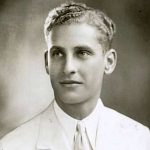 When a vicious killer is caught, sometimes the townspeople lose control of their emotions and take matters into their own hands. While it is a little less common these days, people would sometimes storm the jail to execute the prisoners themselves. Often it was thought that justice would not be served in the court system. People fear the possibility that the killer might get off and be back out in society again. These days, it is pretty hard to storm a jail, but jails weren’t as secure then, as they are now.
When a vicious killer is caught, sometimes the townspeople lose control of their emotions and take matters into their own hands. While it is a little less common these days, people would sometimes storm the jail to execute the prisoners themselves. Often it was thought that justice would not be served in the court system. People fear the possibility that the killer might get off and be back out in society again. These days, it is pretty hard to storm a jail, but jails weren’t as secure then, as they are now.
On November 9, 1933, Brooke Hart was abducted by two men in his own Studebaker. His family received a $40,000 ransom demand and, soon after, Hart’s wallet was found on a tanker ship in a nearby bay. The investigative trail led to John Holmes and Thomas Thurmond, who implicated each other in separate confessions. Both acknowledged, that Hart had been pistol-whipped and then thrown off the San Mateo Bridge. After Hart’s body 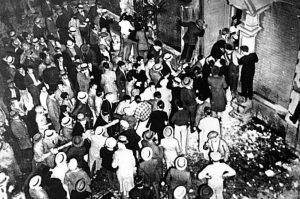 washed ashore on November 25, a vigilante mob began to form. Newspapers reported the possibility of a lynching and local radio stations broadcast the plan. Not only did Governor James Rolph reject the National Guard’s offer to send assistance, he reportedly said he would pardon those involved in the lynching. Now, when you have a governor who is on the side on the lynch mob, you have a volatile situation.
washed ashore on November 25, a vigilante mob began to form. Newspapers reported the possibility of a lynching and local radio stations broadcast the plan. Not only did Governor James Rolph reject the National Guard’s offer to send assistance, he reportedly said he would pardon those involved in the lynching. Now, when you have a governor who is on the side on the lynch mob, you have a volatile situation.
On November 26, 1933, thousands of people in San Jose, California, stormed the jail where Thomas Thurmond and John Holmes were being held. The angry mob converged at the jail and beat the guards, using a battering ram to break into the cells. Then, Thurmond and Holmes were dragged out and hanged from large trees in a nearby park. Contrary to the way most of us think, when our emotions aren’t raw, the public seemed to welcome the gruesome act of vigilante violence. After the incident, pieces of the lynching ropes were sold to 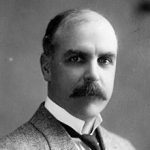 the public. Though the San Jose News declined to publish pictures of the lynching, it condoned the act in an editorial. Seventeen-year-old Anthony Cataldi bragged that he had been the leader of the mob but he was not held accountable for his participation. At Stanford University, a professor asked his students to stand and applaud the lynching. Perhaps most disturbing, Governor Rolph publicly praised the mob. “The best lesson ever given the country,” said Governor Rolph. “I would like to parole all kidnappers in San Quentin to the fine, patriotic citizens of San Jose.” I understand the anger, but not the method. While the two killers might have deserved the death penalty for their crimes, this was not the way it should have happened. Nevertheless, I guess justice was served…even if it was vigilante justice.
the public. Though the San Jose News declined to publish pictures of the lynching, it condoned the act in an editorial. Seventeen-year-old Anthony Cataldi bragged that he had been the leader of the mob but he was not held accountable for his participation. At Stanford University, a professor asked his students to stand and applaud the lynching. Perhaps most disturbing, Governor Rolph publicly praised the mob. “The best lesson ever given the country,” said Governor Rolph. “I would like to parole all kidnappers in San Quentin to the fine, patriotic citizens of San Jose.” I understand the anger, but not the method. While the two killers might have deserved the death penalty for their crimes, this was not the way it should have happened. Nevertheless, I guess justice was served…even if it was vigilante justice.
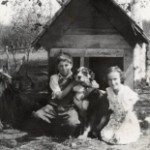
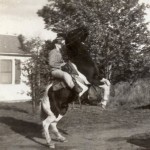 My Aunt Ruth Wolfe was raised on a farm, around horses, and she loved them, as well as most other animals. She really thrived on the country life. She worked hard, alongside her mom and siblings, especially during World War II, when her brother, my dad, Allen Spencer was serving in the Army Air Forces. She helped at the farm and also as a welder at the shipyards…one of the women known as riveters. Later in her life, when she was married, she and my Uncle Jim Wolfe lived in the country outside Casper, Wyoming. They gardened, canned, and raised farm animals. Aunt Ruth was one tough lady. She could do just about anything she set her mind to. From that hard work of farming, to canning, to haying, to playing any instrument, to painting, my Aunt Ruth was simply a multi-talented woman.
My Aunt Ruth Wolfe was raised on a farm, around horses, and she loved them, as well as most other animals. She really thrived on the country life. She worked hard, alongside her mom and siblings, especially during World War II, when her brother, my dad, Allen Spencer was serving in the Army Air Forces. She helped at the farm and also as a welder at the shipyards…one of the women known as riveters. Later in her life, when she was married, she and my Uncle Jim Wolfe lived in the country outside Casper, Wyoming. They gardened, canned, and raised farm animals. Aunt Ruth was one tough lady. She could do just about anything she set her mind to. From that hard work of farming, to canning, to haying, to playing any instrument, to painting, my Aunt Ruth was simply a multi-talented woman.
I think one of the strangest moves Aunt Ruth and Uncle Jim made was the one to Vallejo, California. I couldn’t quite figure out why a person who loved the country so much, would move to a city. Vallejo is a suburb of San Francisco, California, and very different from Casper, Wyoming or Holyoke, Minnesota. I suppose they decided that they wanted a change of pace, and I can understand that, because my family and I lived in the country for a number of years before we moved into town in Casper. For us, the city life was more…us, at least the small city life. I don’t think I would want to live in a big city like New York or San Francisco. Still, I can understand why my aunt and uncle might be drawn to the big city life, and the warmer California weather.
After a time in California, the quiet country life again drew them from the big city to the mountains of Washington state. I can’t say that the move to the mountains surprised me much, because it seems like country life was like the blood that ran through my aunt and uncle’s veins. It was a part of who they were, as 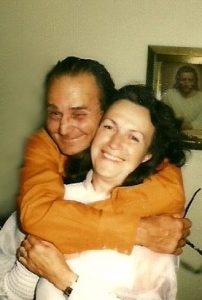
 much as their DNA was who they were. Once they settled in eastern Washington, they never moved again. They bought the top of a mountain, and built three cabins there…one for them, one for their daughter, Shirley and her husband, Shorty Cameron; and one for their son Terry and his family. For Aunt Ruth and Uncle Jim, this would be their forever home. Having been on their mountain top, I can say that I understand why they thought it was so beautiful, but in the years since I moved back to town, I know that I would not want to live permanently in the country, or on a mountain top again. Nevertheless, that was their favorite place to be. Today would have been my Aunt Ruth’s 92nd birthday. It’s hard to believe she has been gone 26 years now. Happy birthday in Heaven Aunt Ruth. We love and miss you so very much, and can’t wait to see you again.
much as their DNA was who they were. Once they settled in eastern Washington, they never moved again. They bought the top of a mountain, and built three cabins there…one for them, one for their daughter, Shirley and her husband, Shorty Cameron; and one for their son Terry and his family. For Aunt Ruth and Uncle Jim, this would be their forever home. Having been on their mountain top, I can say that I understand why they thought it was so beautiful, but in the years since I moved back to town, I know that I would not want to live permanently in the country, or on a mountain top again. Nevertheless, that was their favorite place to be. Today would have been my Aunt Ruth’s 92nd birthday. It’s hard to believe she has been gone 26 years now. Happy birthday in Heaven Aunt Ruth. We love and miss you so very much, and can’t wait to see you again.
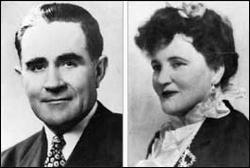 Everyone, at one time or another in their lives has thought about what it might be like to find a hidden treasure. There are many ways that could happen, from a hidden gold mine, to an auction, to the attic, but few can match what it would be like to find a buried treasure in a gold mine. It was the stuff dreams were made of, especially in the Old West. When gold was discovered in California, the Gold Rush started, and while few people ever found their fortune, many people made the journey to try their luck.
Everyone, at one time or another in their lives has thought about what it might be like to find a hidden treasure. There are many ways that could happen, from a hidden gold mine, to an auction, to the attic, but few can match what it would be like to find a buried treasure in a gold mine. It was the stuff dreams were made of, especially in the Old West. When gold was discovered in California, the Gold Rush started, and while few people ever found their fortune, many people made the journey to try their luck.
Victorio Peak was not in California, but it was said to hold a huge cache of gold ingots. The treasure was first discovered by a soldier, who on his death bed in the 1600s, told a monk in a New Mexico monastery about his knowledge of a secret cache of gold ore in the mountains. The monk was Padre Felipe LaRue. LaRue put together a band that purportedly located the mine and successfully drew ore from it for three solid years. When 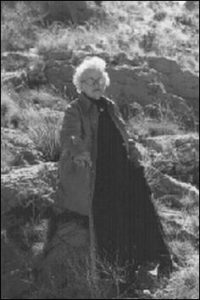 the Mexican Army was sent to overtake LaRue’s operation, he ordered workers to close the entrance to the mine with a landslide and, soon thereafter, LaRue’s entire camp took information about the location with them to the grave at the hands of the soldiers.
the Mexican Army was sent to overtake LaRue’s operation, he ordered workers to close the entrance to the mine with a landslide and, soon thereafter, LaRue’s entire camp took information about the location with them to the grave at the hands of the soldiers.
Fast forward to 1937, when a New Mexico couple named Ernest and Ova Noss were said to have stumbled upon a narrow entrance to this mine while hunting, and then returned several times to collect the heavy gold ingots from the secret location. When Ernest tried to open the mine further with a blast of TNT, it was inadvertently sealed despite repeated attempts to reopen it. When the White Sands Missile and Bombing Range was expanded in 1955 to include the land, Ova Noss supposedly sent a party to investigate and they reported that Army officials were seen digging near the site. Still, the Army never made any mention of the Victorio gold.
In 1977, ground-penetrating radar identified an open area underground near where the Noss’ claim might have been. In the 1990s, a locked steel door was said to have been found covering the site of the original shaft.  Whatever the case may be, a reported 88 solid gold ingots were brought forth from the mountains of New Mexico by the Noss couple, and it is unlikely the public will ever know exactly what became of the site and its associated treasure. Some people think the whole legend is a con, but shortly before her death in 1979, Ova Noss was a the White Sands Missile Range seeking access to her claim. Access was denied, and to this day her family and their organization called The Ova Noss Family Partnership continue to push for access to the mine, although in my mind, it is doubtful that they would find much today, since the mine has been under the exclusive control of the missile base for a long time.
Whatever the case may be, a reported 88 solid gold ingots were brought forth from the mountains of New Mexico by the Noss couple, and it is unlikely the public will ever know exactly what became of the site and its associated treasure. Some people think the whole legend is a con, but shortly before her death in 1979, Ova Noss was a the White Sands Missile Range seeking access to her claim. Access was denied, and to this day her family and their organization called The Ova Noss Family Partnership continue to push for access to the mine, although in my mind, it is doubtful that they would find much today, since the mine has been under the exclusive control of the missile base for a long time.

